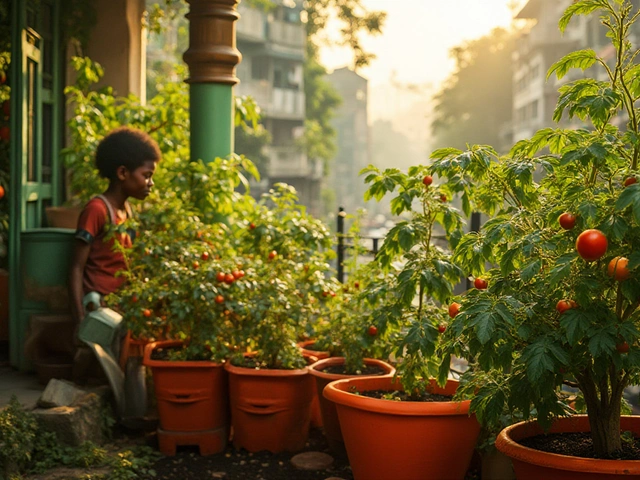Picture this: it’s the dead heat of August, water bills sky-high, and your tomatoes look hangrier than a Labrador at dinnertime. A sustainable garden isn’t just about hugging trees or ditching the chemicals—it’s about working smarter, not harder, using what you have and cutting the stuff that drags you down. Right now, some yards gulp up to 70% more water than they need, while tons of food waste hit landfills instead of compost bins. Seems backward, right?
There’s good news: with some fresh habits and simple ideas, your garden can become an eco-friendly powerhouse—less hassle for you, and a win for Max (my dog, who can sniff out weeds like a champ). We’re going deep, past the usual “use mulch” advice, to the real-life stuff that stands up to wild weather, lazy afternoons, and busy weeks. There’s enough greenwashing out there, so let’s stick with ideas that work. Whether your patch is a postage-stamp or a jungle, making it sustainable means you spend less, sweat less, and help your patch of the planet thrive.
Rethink Water: Smarter Ways to Keep Plants Thriving
First up, water is a game changer. Did you know that, in the U.S., residential outdoor water use accounts for nearly 30% of household water demand, and up to 50% in dry regions? Now, factor in evaporation and overwatering—most gardens waste as much as half the water they absorb, especially in summer. Sustainable gardening flips this.
Switching to a drip irrigation system, for example, can cut water waste by up to 60% compared to old-school sprinklers. Those little tubes put water right at the plant’s roots, where it matters. And if that sounds like too much work, rain barrels are simple: stick one under a downspout and suddenly your next shower keeps your lettuce alive.
Don’t forget mulching! Covering your soil with wood chips, straw, or even shredded leaves can slash water evaporation by as much as 70%. Pick materials that break down slowly—bark, coco coir, or pine needles work nicely. When the soil stays moist, worms and micro-creatures move in, making your dirt better without you lifting a finger.
Wondering about plant choices? Native plants and drought-tolerant varieties get bonus points. Where I live, even sage and rosemary keep humming along with barely a sip, while the neighbor’s thirsty petunias wilt by noon. It’s not just about surviving tough weather—these plants usually need less fertilizer and are less likely to get sick, saving you trips to the garden center.
| Water Conservation Method | Potential Water Savings |
|---|---|
| Drip Irrigation | Up to 60% |
| Rain Barrels | ~1,300 gallons/barrel/year |
| Mulching | Up to 70% less evaporation |
Next time you reach for the hose, pause. Feel the soil with your fingers. If it’s tamped or dry right at the top but cool underneath, your mulch trick is working. If you want to geek out even further, a soil moisture meter costs less than a pizza and saves gallons.
Building Healthy Soil Without Breaking the Bank
Your plants live or die by the dirt under their feet. Forget store-bought fertilizers packed with mystery chemicals. Building rich, complex soil is like giving your garden a savings account for tough times. The secret? Composting, crop rotation, and feeding your dirt, not just your plants.
Here’s a wild stat: the EPA estimates Americans toss over 30 million tons of food waste each year, but a third of that could become garden gold. A backyard compost bin is cheap to start and perfect for turning veggie scraps, coffee grounds, and even shredded newspaper into fertile humus. With good compost, you can reduce chemical fertilizer needs by up to 50%—and your veggies taste better, too.
Don’t stop there. Rotate your crops each season. That means not planting tomatoes in the same spot year after year. Crop rotation stops diseases from settling in and helps the soil restore different nutrients. It keeps away the tomato hornworm invasion Max dreads every July. Grow beans or peas in one patch one season—they feed the soil with nitrogen. Next year, swap in squash or cucumbers and let them soak up the goodness.
Cover crops are another trick. Between planting seasons, try a quick crop of clover, vetch, or even rye grass. Once you chop it down and let it break up in the soil, you’re feeding the underground life and keeping weeds at bay. Plus, roots from these plants hang on to nutrients instead of letting rain wash them away. That’s free “green manure” for the price of a handful of seed.
When it comes to boosting soil (and wrangling food waste), here’s what you can toss in your compost with zero guilt:
- Vegetable and fruit scraps
- Eggshells (crush ’em for faster breakdown)
- Coffee grounds and unbleached filters
- Shredded cardboard, paper towels (no ink or chemicals)
- Autumn leaves, lawn clippings
Skip meat, dairy, and oily stuff. They break down slow, cause smells, and attract raccoons—Max’s sworn enemy. Turn your compost once a week if you can. It speeds things up and keeps things sweet-smelling.
| Soil Enrichment Method | Key Benefit |
|---|---|
| Composting | Organic matter, improved soil fertility |
| Crop Rotation | Disease prevention, nutrient balance |
| Cover Crops | Soil structure, weed control |
If soil is your foundation, treat it with respect. The more life you encourage down there, the easier your garden runs itself. That’s sustainability in action, no fancy gadgets needed.

Plant Smarter: Native Plants and Perennial Power
If there’s one shortcut to a sustainable garden, it’s planning with the long game in mind. Filling your beds with flash-in-the-pan annuals means you’re always digging, buying, and tossing. It’s rough on your back, wallet, and the planet. Instead, bring in native and perennial plants that thrive year after year.
Natives are plants that grew in your region long before you moved in. They know your weather and your bugs and can shrug off dry spells or crazy storms. Studies from local university extensions show native plantings support about 70% more pollinator species than imports or hybrids. Think milkweed for monarchs, coneflowers for bees, or goldenrod for butterflies. Most are tough as nails and nearly impossible to kill (unless, like Max, your dog decides to nap right on top of them).
Perennials don’t just benefit native wildlife—they save you big on effort and money. Once established, these plants might hang around for 5, 10, or even 30 years with just a little trimming and maybe an annual feed or mulch. No buying trays of new seedlings every spring. My favorite showstopper is the black-eyed Susan. It’s cheerful, spreads on its own, and keeps blooming long past the usual peak. Asparagus, rhubarb, chives, and walking onions? They feed you year after year with nearly zero work once they’re in the ground.
If you want to be strategic, mix things up. Interplant your perennials and natives with a few well-considered annuals—maybe some organic heirloom tomatoes or zinnias for cut flowers. Layering different plant heights and growth rates means less bare soil (hello, fewer weeds) and less water lost to sun and wind. This is called polyculture, and it mimics what you’d find on the edge of a forest—nature’s ultimate sustainable design.
- Native perennials (black-eyed Susan, bee balm, switchgrass)
- Herbs that over-winter well (sage, oregano, thyme)
- Low-maintenance shrubs (blueberry, serviceberry)
- Wildflowers for pollinators (milkweed, liatris)
| Plant Type | Typical Lifespan | Maintenance Needs |
|---|---|---|
| Annual | 1 season | High |
| Perennial | 2-30 years | Low to moderate |
Don’t be afraid to swap out lawn areas for native grasses—they withstand foot traffic, use less water, and make the neighbors jealous (or at least curious enough to ask how you keep your patch so lively).
Zero Waste: Turning Garden Byproducts Into Resources
Let’s talk about waste. The average gardener hauls pounds of grass clippings, leaves, and branches to the curb each year, missing a chance to close the loop. Turning your garden’s leftovers into resources builds resilience and shrinks your trash can.
Start with grass cycling. Instead of bagging lawn clippings, let your mower drop them back down. They decompose fast and can return up to 25% of the grass’ total yearly nitrogen needs, no extra fertilizer required. Chop and drop is another easy technique—cut down spent annuals or leggy perennials and toss them right onto the soil as mulch. They keep weeds down and feed the worms that aerate your soil underneath.
Autumn leaves? Don’t bag them. Run the lawn mower over a pile and use them as free mulch or blend them into your compost. Leaf mold—a fancy word for decomposed leaves—holds a shocking amount of water, up to 500% its weight, and improves soil structure. Think of it as a sponge for your summer veggies. If you want to go further, a backyard worm bin (vermicompost) uses red wigglers to eat food scraps and spit out castings—the richest plant food you can get. Studies show worm compost boosts plant growth by 20% or more, outpacing chemical fertilizers head-to-head.
If pruning and trimmings are piling up, try hugelkultur—bury logs, branches, and woody debris under a new bed or mound. Not only does it cut down trips to the landfill, but as the wood breaks down, it acts like a slow-release sponge. You’ll water less, and the mound will feed your plants for years.
- Grass clippings – lawn fertilizer
- Shredded leaves – mulch and water retention
- Small branches and twigs – base for hugelkultur or chipped as path material
- Spent plants – mulch or compost ingredients
| Garden Waste Practice | Result |
|---|---|
| Grass Cycling | Natural fertilizer, less yard waste |
| Composting | Soil improvement, landfill reduction |
| Leaf Mold | Water retention, better structure |
| Hugelkultur | Water savings, long-term soil food |
When you start seeing "waste" as free resources, the entire rhythm of your gardening changes. Production and clean-up blend together. Suddenly the stuff you dreaded dealing with turns into the good stuff that powers your next harvest. Max still goes after squirrels, but at least he doesn’t chase the garbage truck.
Wrap all this together and you’ve got a sustainable gardening routine that saves time, saves money, and keeps your patch lively for years to come. Take these strategies and tweak them for your space—no fancy upgrades, just smarter habits and a little local knowledge. The climate gets weirder, but your garden doesn’t have to struggle with it. And if you catch Max napping in the strawberry bed, don’t say I didn’t warn you.





